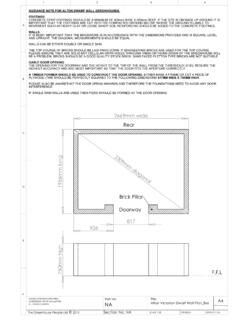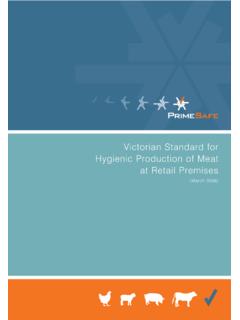Transcription of The Walls - History of York
1 The WallsFrom Medieval Defence to victorian walk through 1,900 years of historyThe Bar Walls of York are the finest and most complete of any town in England. There are five main bars (big gateways),one postern (a small gateway) one victorian gateway, and 45 towers. At two miles ( kilometres), they are also thelongest town Walls in the country. Allow two hours to walk around the entire medieval times the defence of the city relied not just on the Walls but on the rampart underneath and the ditchsurrounding them. The ditch, which has been filled in almost everywhere, was once 60 feet ( ) wide and 10 feet (3m)deep!
2 The Walls are generally 13 feet (4m) high and 6 feet ( ) wide. The rampart on which they stand is up to 30 feethigh (9m) and 100 feet (30m) wide and conceals the earlier defences built by Romans, Vikings and Normans. The Roman defencesIn AD71 the Roman 9th Legion arrived at the strategic spot wherethe rivers Ouse and Foss met. They quickly set about building asound set of defences, as the local tribe the Brigantes were notvery friendly. The first defences were simple: a ditch, an embankment made ofturf and clay, a large timber fence, and timber towers and fortress was big enough to accommodate the 6,000 or somen of the legion.
3 Inside the defences you could comfortably fit50 football pitches. By the third century AD a visitor to York would have found beenmet by massive stone defences which surrounded both thefortress and the large and prosperous civilian town which hadgrown up on the opposite bank of the Ouse (The Micklegate side).One of the most important parts of these defences theMultangular Tower is still here today. The VikingsThe fate of the Walls during the dark ages is shrouded inmystery. In the eighth century Alcuin wrote about the high Walls ofthe City of York. By AD867, however, the Walls had fallen intodisrepair and were unable to resist the great pagan army of theVikings led by Ivar the the Vikings York experienced a boom that was not to berepeated until the victorian period and the arrival of the prosperous Kingdom of Jorvik was coveted by Viking andEnglish Kings alike and as trade and prosperity grew so did theneed to modernise the ancient defences.
4 The Vikings began bycovering the Roman Walls with a broad earth embankmentcrowned with a timber fence. Over time they extended thedefences to the edges of the all-important rivers. The NormansIt took William The Conqueror two years to move north after hisvictory at the Battle of Hastings in 1066. In 1068 anti-Normansentiment in the north was gathering steam around , when William marched north to quell the potential forrebellion his advance caused such alarm that he entered the cityunopposed. Immediately upon his arrival The Conqueror built a castle fromwhich to control this hostile territory.
5 In fact in York he built twocastles, both of earth and wood, one on each bank of the rampart surrounding the city was extended and raised andthe River Foss was also dammed to create an impassableexpanse of open water, which became known as The King sFishpool . From Medieval defence to victorian promenadeIn 1226 the King authorised the city to raise money for the upkeepof the Walls by imposing murage taxes on goods brought intothe city. This allowed the stone Walls which you see today to bebuilt. In the centuries that followed the Walls protected York fromrebels and from the Scots and were battered by Parliamentaryartillery during a three month siege in 1800, however, the bar Walls almost became a thing of the pastwhen the City Council applied to Parliament for permission to improve the city by demolishing the Walls !
6 They began bydestroying Walls and towers at St Leonard s Place andSkeldergate. A campaign of public resistance led to the formationof the York Footpath Association who set about restoring sectionsof the wall and creating the walk featured on this trail. Nowadaysthe focus is on conservation and the City of York Council spendsaround 100,000 a year on its Walls conservation programme. Disabled accessUnfortunately the Bar Walls are inaccessible to many people. However,the Walls can be followed at ground level with the exception of the sectionalong Gillygate. Closing timesWith the safety of the public in mind the Walls are closed before sunsetevery evening and re-open at 8am.
7 Exact times are available from theTourist Information Centre. In bad weather the Walls will remain Speed s Map of York 161012345768910111213141516 Startof the walk is in theMuseum GardensTheLocation for the start of the walk which is 10 minutes walk from the Railway Station, close to carparks at Marygate and Union Terrace and very close to the Park & Ride terminus on MusuemStreet (Green Line).1. The Multangular TowerThe best place to start your tour of the Walls is in the Museum Gardens whereone of the most important parts of the Roman defences the MultangularTower can be seen. The Multangular Tower was probably built at thecommand of the Emperor Septimius Severus who ruled the Roman Empirefrom York from 208 to 211.
8 The tower has 10 sides and is nine metres there were three floors on the inside and a roof on top. In Romantimes it formed the western corner of the great fortress wall. There was amatching tower at the south corner of the fortress (under modern Feasegate).Long after the Romans had left the Multangular Tower continued in use. Thelower part, which has small rectangular facing stones, is Roman while theupper part, identifiable by larger blocks, is use care and common sense when walking the Walls . They are ascheduled ancient monument. The steps are worn and there are norailings in places. A walk around the Bar Walls of YorkThe gateways through York s defences are called bars.
9 The name has its origins in the simplegates, which were used to block the gateways to keep people out. There are five main bars (biggateways), one postern (a small gateway) one victorian gateway, and 45 towers. The bars alsoacted as control points where people had to pay tolls on items brought into the city. They werenormally locked at 9pm and the keys kept by the Mayor. 2. The River DefencesBefore crossing Lendal Bridge, follow the footpath down to theriver s edge where you will find the 13th century Lendal Tower is very unusual in that from 1631 it was used as awater-tower, one of the earliest in the country.
10 On the opposite bankof the river is the 14th century Barker Tower. An iron chain could bestretched between the towers to close the river in times of troubleand to ensure that boatmen paid a toll. Further downriver, nearpresent-day Skeldergate Bridge, stood another pair of towers witha chain in between. Take a look inside the Multangular Tower5. Victoria BarAfter Micklegate the wall -walk passes close by the rooftops of peacefulBishophill and over Victoria Bar, which was opened in 1838 by the famousLord Mayor of the time, George Hudson Esq. (the Railway King). Furtheralong look out for the chessboard pattern carved into one of the flagstones!






